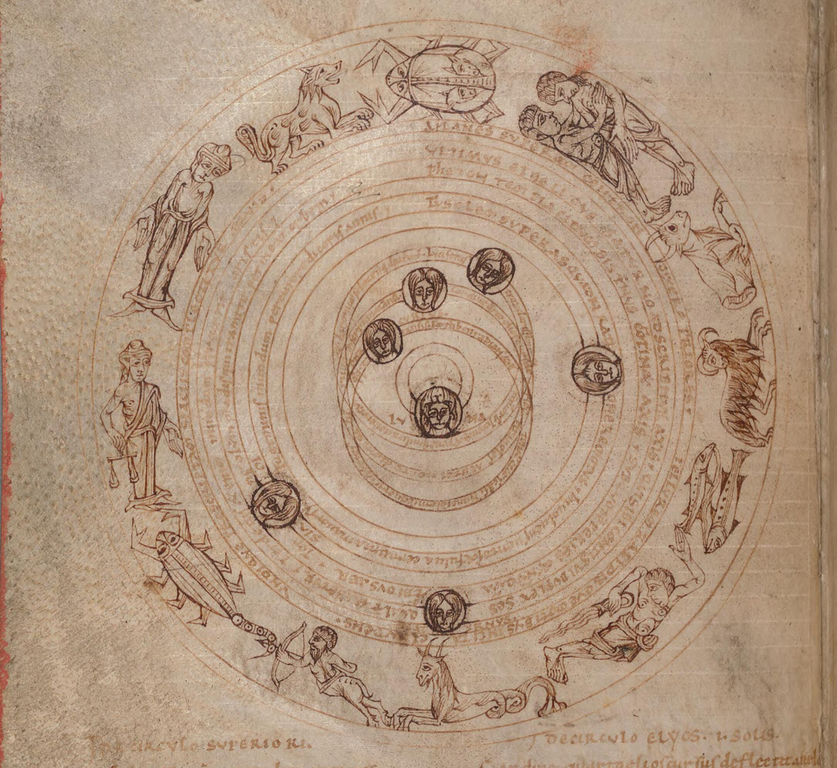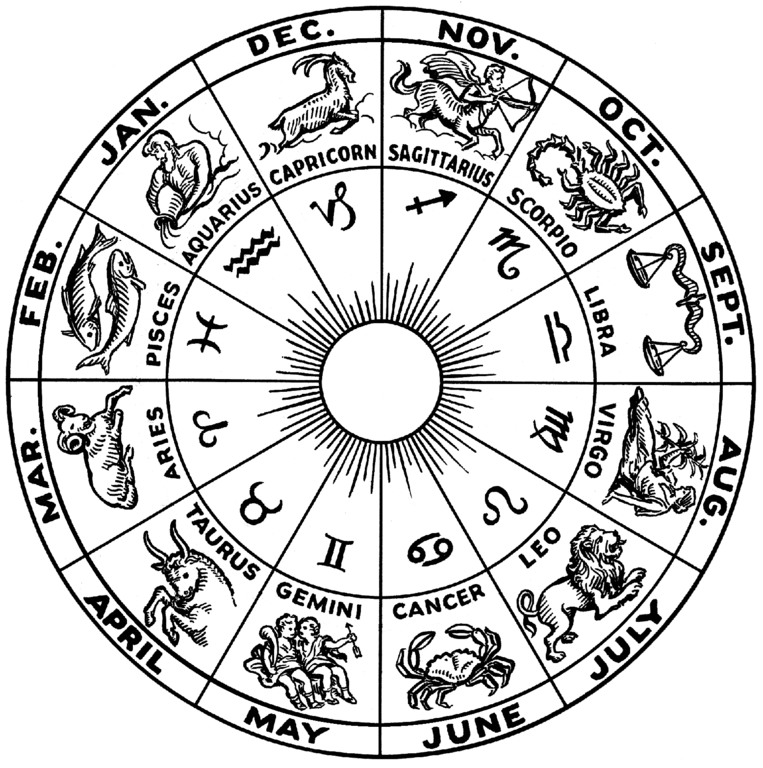Zodiac
The zodiac is a belt-shaped region of the sky that extends approximately 8° north or south (as measured in celestial latitude) of the ecliptic, the apparent path of the Sun across the celestial sphere over the course of the year. The paths of the Moon and visible planets are within the belt of the zodiac.
The zodiac is a fundamental aspect of astrology and the casting of horoscopes.
Name
The English word zodiac derives from zōdiacus, the Latinized form of the Ancient Greek zōdiakòs kýklos (ζῳδιακός κύκλος), meaning "cycle or circle of little animals." Zōdion (ζῴδιον) is the diminutive of zōon (ζῷον, "animal"). The name reflects the prominence of animals (and mythological hybrids) among the twelve signs.
Composition
As each sign takes up exactly 30 degrees of the zodiac, the average duration of the solar stay in each sign is one twelfth of a sidereal year, or 30.43 standard days. Due to Earth's slight orbital eccentricity, the duration of each sign varies appreciably, between about 29.4 days for Capricorn and about 31.4 days for Cancer. In addition, because the Earth's axis is at an angle, some signs take longer to rise than others, and the farther away from the equator the observer is situated, the greater the difference. Thus, signs are spoken of as "long" or "short" ascension.
In Western astrology, and formerly astronomy, the zodiac is divided into twelve signs, each occupying 30° of celestial longitude and roughly corresponding to the star constellations:
Usage
The zodiac was in use by the Roman era, based on concepts inherited by Hellenistic astronomy from Babylonian astronomy of the Chaldean period (mid-1st millennium BC), which, in turn, derived from an earlier system of lists of stars along the ecliptic. The construction of the zodiac is described in Ptolemy's comprehensive 2nd century AD work, the Almagest.
Although the zodiac remains the basis of the ecliptic coordinate system in use in astronomy besides the equatorial one, the term and the names of the twelve signs are today mostly associated with horoscopic astrology. The term "zodiac" may also refer to the region of the celestial sphere encompassing the paths of the planets corresponding to the band of about 8 arc degrees above and below the ecliptic. The zodiac of a given planet is the band that contains the path of that particular body; e.g., the "zodiac of the Moon" is the band of 5° above and below the ecliptic. By extension, the "zodiac of the comets" may refer to the band encompassing most short-period comets.
History
The zodiac and system of astrology currently in use in the Western world today has no real connection to the astrology used by the ancient Egyptians, although they do sometimes utilize the same stars. The Egyptian system was based on the fixed stars, specifically Sirius and the movement of the decanal stars across the night sky. Although the Egyptians did organize the decans into groups, these were not in any way similar to the "connect the dots" constellations of Hellenistic and Persian astrology.
The division of the ecliptic into the zodiacal signs originates in Babylonian astronomy during the first half of the 1st millennium BC. The zodiac draws on stars in earlier Babylonian star catalogues, such as the MUL.APIN catalogue, which was compiled around 1000 BC. Some constellations can be traced even further back, to Bronze Age (First Babylonian dynasty) sources, including Gemini "The Twins," from MAŠ.TAB.BA.GAL.GAL "The Great Twins," and Cancer "The Crab," from AL.LUL "The Crayfish," among others.
Around the end of the 5th century BC, Babylonian astronomers divided the ecliptic into 12 equal "signs", by analogy to 12 schematic months of 30 days each. Each sign contained 30° of celestial longitude, thus creating the first known celestial coordinate system. According to calculations by modern astrophysics, the zodiac was introduced between 409 and 398 BC, during Persian rule, and probably within a very few years of 401 BC. Unlike modern astrologers, who place the beginning of the sign of Aries at the position of the Sun at the vernal equinox in the Northern Hemisphere (March equinox), Babylonian astronomers fixed the zodiac in relation to stars, placing the beginning of Cancer at the "Rear Twin Star" (β Geminorum) and the beginning of Aquarius at the "Rear Star of the Goat-Fish" (δ Capricorni).
Due to the precession of the equinoxes, the time of year the Sun is in a given constellation has changed since Babylonian times, the point of March equinox has moved from Aries into Pisces.
Because the division was made into equal arcs, 30° each, they constituted an ideal system of reference for making predictions about a planet's longitude. However, Babylonian techniques of observational measurements were in a rudimentary stage of evolution. They measured the position of a planet in reference to a set of "normal stars" close to the ecliptic (±9° of latitude) as observational reference points to help positioning a planet within this ecliptic coordinate system.
In Babylonian astronomical diaries, a planet position was generally given with respect to a zodiacal sign alone, less often in specific degrees within a sign. When the degrees of longitude were given, they were expressed with reference to the 30° of the zodiacal sign, i.e., not with a reference to the continuous 360° ecliptic.
Hebrew astronomy and astrology
Knowledge of the Babylonian zodiac is said to be reflected in the Hebrew Bible; E. W. Bullinger interpreted the creatures appearing in the book of Ezekiel as the middle signs of the four quarters of the zodiac, with the Lion as Leo, the Bull is Taurus, the Man representing Aquarius and the Eagle representing Scorpio. Some authors have linked the twelve tribes of Israel with the same signs or the lunar Hebrew calendar having twelve lunar months in a lunar year. Martin and others have argued that the arrangement of the tribes around the Tabernacle (reported in the Book of Numbers) corresponded to the order of the zodiac, with Judah, Reuben, Ephraim, and Dan representing the middle signs of Leo, Aquarius, Taurus, and Scorpio, respectively.
Use in astronomy
The Sun's placement upon the vernal equinox, which occurs annually around 21 March, defines the starting point for measurement, the first degree of which is historically known as the "first point of Aries". The first 30° along the ecliptic is nominally designated as the zodiac sign Aries, which no longer falls within the proximity of the constellation Aries since the effect of precession is to move the vernal point through the backdrop of visible constellations (it is currently located near the end of the constellation Pisces, having been within that constellation since the 2nd century AD). The subsequent 30° of the ecliptic is nominally designated the zodiac sign Taurus, and so on through the twelve signs of the zodiac so that each occupies 1⁄12th (30°) of the zodiac's great circle. Zodiac signs have never been used to determine the boundaries of astronomical constellations that lie in the vicinity of the zodiac, which are, and always have been, irregular in their size and shape.
The convention of measuring celestial longitude within individual signs was still being used in the mid-19th century, but modern astronomy now numbers degrees of celestial longitude continuously from 0° to 360°, rather than 0° to 30° within each sign. This coordinate system is primary used by astronomers for observations of solar system objects.
The use of the zodiac as a means to determine astronomical measurement remained the main method for defining celestial positions by Western astronomers until the Renaissance, at which time preference moved to the equatorial coordinate system, which measures astronomical positions by right ascension and declination rather than the ecliptic-based definitions of celestial longitude and celestial latitude. The orientation of equatorial coordinates are aligned with the Earth's axis of rotation, rather than the plane of the planet's orbit around the Sun.
The word "zodiac" is used in reference to the zodiacal cloud of dust grains that move among the planets, and the zodiacal light that originates from their scattering of sunlight. While its name is derived from the zodiac, the zodiacal light covers the entire night sky, with enhancements in certain directions.
| Signs of the Tropical Zodiac | |||
|---|---|---|---|
| Aries Mar 21 - Apr 20 |
Taurus Apr 21 - May 21 |
Gemini May 22 - Jun 23 |
Cancer Jun 24 - Jul 23 |
| Leo Jul 24 - Aug 23 |
Virgo Aug 24 - Sep 22 |
Libra Sep 23 - Oct 23 |
Scorpio Oct 24 - Nov 22 |
| Sagittarius Nov 23 - Dec 21 |
Capricorn Dec 22 - Jan 19 |
Aquarius Jan 20 - Feb 18 |
Pisces Feb 18 - Mar 20 |


